Lenses
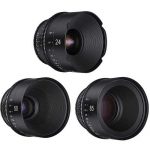
Please, see my extensive tutorial “Lenses – Beginnner’s Guide”. It should answer most of your questions about lenses. Among other things, it talks about how you can save a lot of money by buying used manual lenses, especially the Nikon (a great place to look for these lenses is eBay).
Good lenses are important but some people put too much importance on having the best lenses. It is easy to overspend in this area, but if you’re smart and shop around, you can build up a nice assortment of lenses for a reasonable cost. Also, having a varied selection of lenses is more important than having lenses with the best specifications but fewer of them.
One mistake I see filmmmakers make is to go for the super-fast lenses (i.e. large aperture – low f-stop number). Yes, it is nice to have a fast lens – because you can shoot with less light – but if you use a very large aperture, keeping your subjects in focus becomes a challenge. For example, I see filmmakers use very wide aperture on steadicam shots, and then get surprised that they cannot keep their actors in focus.
I strongly recommend buying lenses with Canon’s EF mount, even if you don’t own a Canon camera at the moment. If you have a long career as a filmmaker, you’r unlikely to stick with one brand of cameras – you will most likely upgrade cameras, but not the lenses you own. The EF mount lenses are the easiest lenses to adapt.
Of course, there are some native lenses that are a good buy too. For example, for Panasonic cameras, I really like the Panasonic Lumix G X Vario f/2.8 lenses.
Speaking of native lenses, usually kit zoom lenses offer good value, so they are a good place to start your lens collection.
For example, I really like the Sony E 16-55mm F3.5-5.6 OSS on my Sony a6500. Although the specs don’t seem impressive, this is the lens I use the most on this camera. It is small, just like the a6500 camera body, and I find this combo perfect for gimbals.
If your camera doesn’t come with a kit lens, or you can spend extra money, here are some really good zoom lenses.
If you want just one Sony lens for a Sony APS-C (E-mount) camera (like a6500), then here is a versatile zoom lens that is very popular among Sony users:
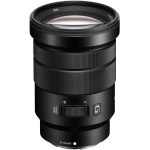
Sony E PZ 18-105mm f/4 G OSS lens on BH Photo Video, Amazon, Amazon Canada, Amazon UK, Amazon Germany
For Panasonic cameras, I really like the Panasonic Lumix G X Vario f/2.8 lenses, as I mentioned earlier. These zoom lenses come in 12-35mm and 35-100mm focal ranges. Also, you can choose between two generations. The second generation improves the image stabilization – it supports Dual I.S. 2 while the first generation supports in-body image stabilization up to Dual I.S. 1. In practical terms, though, the improvement is not significant, and since the older lenses are usually discounted, I think they offer more value.
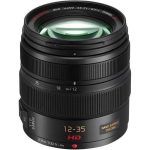
Panasonic Lumix G X Vario 12-35mm f/2.8 Asph. lens on BH Photo Video, eBay, Adorama, Amazon, Amazon U.K., Amazon Canada, Amazon Germany
Panasonic Lumix G X Vario 35-100mm f/2.8 Asph. lens on BH Photo Video, eBay, Adorama, Amazon, Amazon U.K., Amazon Canada, Amazon Germany
Panasonic Lumix G X Vario 12-35mm f/2.8 II lens (2nd gen.) on BH Photo Video, Adorama
Panasonic Lumix G X Vario 35-100mm f/2.8 II lens (2nd gen.) on BH Photo Video, Adorama
50mm Prime Lenses
The next lens I recommend getting is a 50mm prime lens (full frame equivalent; the nifty fifty). 50mm lenses approximate the field of view of our eyes and are very versatile. Plus, with the prime lens, you will be able to shoot with less light and have a sharper image. Also, these lenses are generally not expensive, unless you go for a very fast lens.
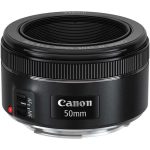
Here are my picks:
Canon EF 50mm f/1.8 II Camera Lens on Amazon, BH Photo Video, eBay
Sony E 50mm F1.8 lens on BH Photo Video, Amazon
Panasonic Lumix G 25mm f/1.7 ASPH. lens on BH Photo Video, Henry’s, eBay, Amazon, Amazon Canada, Amazon UK, Amazon Germany
Sigma 50mm f/1.4 EX DG HSM Lens EF-mount on Amazon
Once you have a solid native zoom and a nifty-fifty prime, you can take two very different routes, depending on the type of projects you make.
If your work is primarily films and music videos, i.e. projects where you usually have control over the lighting and your subjects, then you should go for a kit of cinema lenses. Please go to “Film Industry Lenses” at the end of this article for more information.
If your projects are run-and-gun, like documentaries, TV field reports, weddings, events (and also corporate), you don’t need as many lenses, but the ones you get need to be versatile and fast. Therefore, you should go for zoom lenses that cover a wide range of focal lengths, and that work well in low light. Filming in situations where you have little control means that you cannot change your lenses often, therefore versatility is crucial.
Here are some great choices:
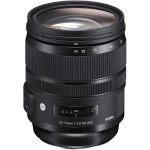
Sigma 24-70mm f/2.8 DG OS HSM Art Lens on BH Photo Video
This is a lot of money to spend on a lens, but, again, it’s a fast, versatile zoom. It really is a beautiful lens.
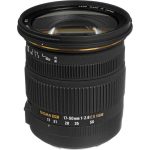
Fortunately, here is a much more economical medium zoom lens that I personally own and use. It’s also fast and sharp, and with a good range.
Sigma 17-50mm f/2.8 EX DC OS HSM Zoom Lens on BH Photo Video
Wide-angle Lenses
Last on my list would be a wide-angle lens, whether prime or zoom. I find them quite useful on music videos, and when shooting indoors on location (as opposed to a set) – the space can often be tight. Also, these lenses are usually fast, so they are useful when working with little light.
For extreme wide shots, here is an affordable option (it’s a lens I own)
Sigma 10-20mm f/3.5 EX DC HSM lens for Canon on Amazon, BH Photo Video
Telephoto Zoom Lenses
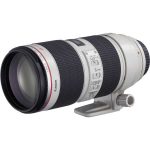
As you continue to add to your lens collection, you should turn your attention to long zoom lenses. There are some excellent 70-200mm telephoto zooms. Here is probably the best one of them all:
Canon EF 70-200mm f/2.8L IS II USM Lens on BH Photo Video
Here is an option from Tamaron that’s cheaper but almost as good
Tamron SP 70-200mm f/2.8 Di VC USD G2 Lens on BH Photo Video
You’re unlikely to ever need a lens longer than 200 mm.
Film Industry Lenses
When you work on films and music videos, you have control over the lighting, movement of actors, etc. This allows you to change lenses more often. Filmmakers who work in these situations usually opt for lenses with bigger, sharper glass elements. This way, they gain in image quality, although lose lens flexibility.
Cinema lenses are available as zooms too, but they are very expensive. That is why primes are the more common choice.
It is important to note that cinema lenses do not have autofocus. Instead, they have a physical ring that allows to use a traditional follow focus system, or wireless focus system, and gives a smooth pull for a great control over the iris (an aperture ring is usually also present).
An example of great cinema lenses is the Rokinon Xeen line. However, these lenses are very expensive. I recommend getting a set of Rokinon Cine DS lenses, instead.
Here‘s a video where I test and compare the Rokinon Cine DS and Xeen lenses.
As I mentioned before, it is a good idea to get lenses in the EF lens mount, since you will be able to adapt them to almost any camera.
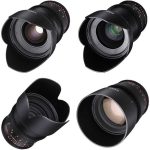
Rokinon Cine DS lenses on BH Photo, Adorama, eBay, Henry’s, Amazon, Amazon Canada
